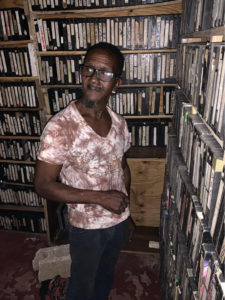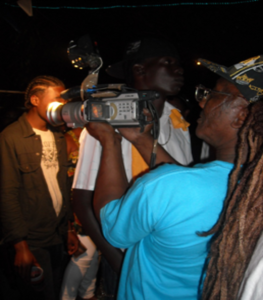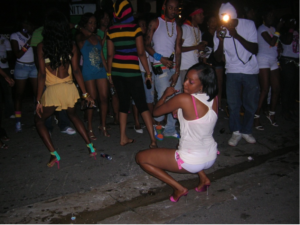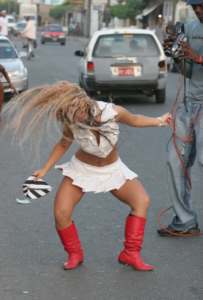Jack Sowah’s Dancehall Archive
Every culture needs adequate archiving of spaces and practices unique to that culture, whether through written words, oral conversations, or audio-visual documentation to survive. The latter has been achieved through the art of videography for decades. When it comes to dancehall and sound system culture, videography has been crucial in its preservation and globalisation. Very little is known about the intricacies of Jamaican dancehall’s ties to visuality as the dominant feature of any dancehall event is the sound. Wrapped neatly inside the soundscape however is the innovation that came with videographers such as Jack Sowah who revolutionised the way dance events were experienced and preserved. As part of the Sonic Street Technologies Project’s exploration of Jamaican videography, we place the spotlight on Jack Sowah. This post comes as part of the first commissioned research out of Jamaica. It seeks to answer the question – what are the methods, styles, and technologies that have been used to document culture through audiovisual means?
by Sonjah Stanley Niaah, Ashly Cork and Dennis Howard
Introducing Jack Sowah
Jack Sowah, born Courtney Cousins, began his career in dancehall as a recording artist and dancer in the early 1980s. He had already earned the admiration of his community before even touching a camera through dance performances. Transitioning from recording songs and his self-proclaimed ‘creative dancing’, Sowah began recording audio in the dancehall space and later transitioned to video recording based on international demand. Through self-training and creativity, Jack Sowah turned dancehall videography into a cultural phenomenon, a spectacle of performance, multi-sensory escape, and visual culture. He introduced new technologies over the years that have now become staples in the dancehall scene for videographers who have come after him. Sowah has placed himself as the choreographer and chronicler of dancehall and sound system culture and his tapes will be enjoyed and emulated for decades to come.

Jack Sowah in his archive room © SST Team.
Jack Sowah as Self-Trained Phenomenon
The legendary career of dancehall videographer Jack Sowah has proven that there is no right or wrong way to do something you enjoy. Without ‘adequate’ technological training Jack proved that he could produce quality content with determination, an eye for detail, and creativity.
From his dancing days Jack knew he was a star. Jack Sowah’s rise to stardom as a dancehall videographer is a story about determination and resilience. He did not have the formal training with cameras like his 80s-90s videography counterpart and director Leo O’Reggio, but what he did have was an eye for detail, openness to self-critique and immense creativity. Jack Sowah exemplified the DIY (do it yourself) model which has proven to be a significant component of Jamaica’s recording industry and sound system ecosystem.
Gifted two used cameras on separate occasions by his friends, and musicians, Bunny Wailer and Horseman, Jack Sowah started a videography career with zero training. Through his journey of documenting Jamaica’s dancehall and sound system culture, Jack Sowah has experimented with light, movement, performance and colour. His innovation saw the introduction of new technology into dancehall events in particular, which has subsequently changed the way videographers document these spaces. It was Jack’s inquisitiveness and willingness to learn that propelled him into being an innovator.

Jack Sowah in Action © Sonjah Stanley Niaah.
Jack Sowah & New Technology
In his prime, during the 1980s and 1990s, Jack Sowah made huge strides in videography by introducing new technology into the physical dancehall space. Among the most popular forms of technology Jack introduced within dancehall were TV screens where patrons caught on camera would appear live and direct, as well as the infamous ‘video light’ accompanying the camera’s journey around the dancehall. These two forms of technology changed not only how videos were captured and subliminally directed, but it changed the culture for the patrons and how they interacted with each other as well as the physical space of the dancehall.
It has been documented in academic research, music and anecdotes that the dance truly does not begin until the video light is turned on. In “Video Light: Dancehall and the Aesthetics of Spectacular Un-Visibility in Jamaica” recently published in Dancehall: A Reader on Jamaican Music and Culture (2020), Thompson documented that “…the proceedings seemed activated in the space delineated by the camera’s light. In the estimation of several dancers, there was, ‘no point in dancing’ without the video light” (p. 147).
The happenings with light not only signalled the beginning and end of the dance but also the high points throughout the event. Where the light is shining, that is where action lies and where you must pay attention. Jack Sowah, in introducing the video light to the dancehall space inadvertently also introduced a means of direction to the production of his videography. The video light encouraged the very spectacle he sought to capture through his lens. Spectacle here, as defined by Stanley Niaah in Dancehall: From Slave Ship to Ghetto (2010) refers to, “… any attempt to achieve a striking visual effect, through display or performance, beyond what is considered normative for a participant or onlooker” (p. 168). This spectacle was crucial to the legendary clips that Sowah produced, however, through his introduction of TV screens into the dancehall event Sowah was able to create a whole other element to this notion of spectacle.
Another of Jack Sowah’s innovations, the introduction of TV screens in the dancehall was able to maximize and consolidate the video light’s power to add to the spectacle. In an interview with the Sonic Street Technologies team based in Jamaica, Sowah noted, “..before the TV and monitor, they would run me away saying, ‘move the bright light’!” He highlighted that many patrons sought to stay away from the video light whether out of being shy or for other reasons of seeking anonymity. That quickly changed, Sowah explained, as people began competing for the video light, a chance to be caught on screen, and a moment of fame. They went as far as offering him money to ensure they were captured and shown on the TV screens inside the dance. Among the negative effects, however, was an increase in aggression amongst the patrons who would get emotional and sometimes defensive about their desire to be in the video light over others. Unfortunately, defensive postures often became physical fights in attempts to secure a spot in the footage captured and the live video feed on screen.
Jack Sowah as (Pro)Former
Jack Sowah was infamous for the way he choreographed his videos behind the lens. His goal was not solely to reproduce on film exactly what was taking place in the dance but to, through his actions and encouragement, direct the movement of the patrons he was capturing. Through this process, Jack became a (pro)former: he employed a performance routine to encourage participation which resulted not only in the capture of authentic expressions of the dance but also the facilitation of a larger display of spectacle within the space.
In his own words, Jack told the SST Jamaica team, “…some of the people them that you go up to, they want to get into it but you have to give them like a push start… you have to give them a push start because some of them are shy.” Although Jack began his career as an amateur videographer, in establishing his method of video capture he became a ‘pro’ whose model stands as an influence for those who have come after.

Patron at a dancehall event being videotaped © Sonjah Stanley Niaah.
Globalisation Through Dancehall Videography
The videos produced by Jack Sowah and other such videographers within the dancehall and sound system spaces proved not only to be a crucial factor in the archiving of culture but of its migration to global spaces. The globalisation of dancehall videography has led to the full migration of dancehall culture, with dancehall spaces proliferating in countries far beyond Jamaica’s shores including Italy, Germany, Poland, Brazil and Japan. Many of the sound system owners, dancers and recording artists in these foreign countries have studied and copied what was documented in dancehall footage and reproduced their own interpretations of these practices.
These videos have also proven to aid in the allure of dancehall culture, providing dancehall enthusiasts with a sneak peek of what to expect before they physically step into these spaces. Many times, dancehall and sound system fanatics have hopped on a plane to Jamaica based on a fascination fed by these videos. In creating a diaspora of dancehall, Sowah and his counterparts have also facilitated an influx of tourism into Jamaica over the years specifically to engage in these spaces.
However, these videos have not only had a positive influence on outsiders watching them but the participants themselves as they vie for the video light. These spaces have encouraged the creation of what Stanley Niaah (2019) defined as ‘prime time geographies.’ She uses this term to “signal a certain way in which embodied practices and lifestyles are thrust into a visual domain that accords prime time luminosity for working-class perpetuators of dancehall who would not otherwise receive a taste of mainstream media attention, audience or placement” (p. 5-6). The dancehall space existing as prime time geography is enhanced through videography. This offers the opportunity for dancers, sound system operators and other participants, many of whom lack formal training in their artistry, to be placed within a global network of creatives.
Further, we see the influence of what is known as ‘smaddification’, a term coined by Tony Laing and popularised by renowned academic Rex Nettleford. In its simplest form, ‘smaddification’ is the positive self-worth that we place on ourselves through self-affirming practices, in this case being featured in the video light or TV screen and the possibility of being viewed and adored by fans locally and abroad. There is something entirely powerful about the ability to become visible where one was invisible, gain status, and develop by virtue of such visibility, the capacity to transform one’s social circumstances. For disenfranchised citizens, many of whom live below the poverty line and lack visibility in the conversations about nationhood in Jamaica, the dancehall space is transformational and provides a unique opportunity to become ‘someone’.
The domino effects of the creation of these dancehall videos extend far beyond engaging local audiences. In the age of technology, many former videographers have also taken advantage of digital tools to preserve their archives including social media platforms such as YouTube. Jack Sowah is among the videographers whose works from the 80s and 90s can be found on YouTube. In this sense, the technology and those who use it continue to remain relevant as pivoting becomes the new norm.

Patron at a dancehall event being videotaped © Sonjah Stanley Niaah.
A Legacy of Videography, Spectacle and Culture
Today, Jack Sowah leaves behind a legacy that has crossed generations and offered videography opportunities to several underserved youths. Like many practitioners in the entertainment industry, Jack’s work was hampered by the COVID-19 pandemic and the Government imposed restrictions on entertainment. Being among the only videographers of the time, Jack’s archive is instrumental in the preservation and documentation of dancehall and sound system culture. His footage provides key visual insight into a time and space that was not as widely documented as it is today and for this reason alone ensures the longevity of his work and others who have documented dancehall during this time.
Jack has found solace as a farmer during these precarious times but his work continues. His YouTube page is updated with frequent posts which feature several of his older videos shared digitally. Some of these videos include titles such as, ‘Bunny Wailers Rasta March (Uncut) 2010’, ‘Jim Brown Memorial’ and ‘Stone Love 38th Anniversary’. As Jack Sowah’s massive dancehall archive sits mostly in VHS tapes within a small library today, its significance will multiply as it more consistently straddles social media platforms and the metaverse that will allow new generations access.
Exceeding all limitations as an amateur videographer, Jack Sowah’s influence and innovation on dancehall videography will continue for decades to come. His use of the (pro)former model, his introduction of the video light and the TV screens will long outlive Sowah himself, having global influence far beyond the urban cityscapes in Kingston, Jamaica. These methods have set the standard of dancehall videography today and have contributed to these archives living on as the heights of entertainment and cultural preservation of performance and spectacle in dancehall. As technology and popular culture continue to change, cultural archives such as Jack Sowah’s serve as evidence contributing to the preservation of the authenticity of the times and spaces captured.
Resources
Ellis, B. (n.d.) ‘Education & Smaddification’. The Jamaica Star. Retrieved from: http://old.jamaica-star.com/thestar/20130501/features/features1.html (accessed March 12, 2022)
Stanley Niaah, S. (2010). DanceHall: From Slave Ship to Ghetto. Ottawa: University of Ottawa Press, pp. 168-169.
Stanley Niaah, S. (2019) ‘Prime Time’ Geographies: Dancehall Performance, Visual Communication and the Philosophy of ‘Boundarylessness’, Caribbean Quarterly, Vol. 65:1, 5-26.
Thompson, K. (2020) ‘Video Light: Dancehall and the Aesthetics of Spectacular Un-Visibility in Jamaica.’ in Dancehall: A Reader on Jamaican Music and Culture, Kingston: The Press, UWI, pp. 153-172.
—
Sonjah Stanley Niaah is a Jamaican scholar, cultural activist, writer, blogger and international speaker. Her work focuses on Dancehall, old and new Black Atlantic performance geographies, ritual, dance, festivals, cultural and creative industries, as well as popular culture and the sacred.
Dennis Howard is a scholar and music historian with over 35 years experience in the creative industries, during which he has held several positions at various media houses in Jamaica. He’s a former entertainment journalist, radio presenter, television producer, and record producer.
Ashly Cork is a Jamaican writer, researcher and consultant for cultural projects. Her work is particularly focused on Jamaica’s cultural and creative industries with a special interest in music as a cultural practice and the global migration of it as such.
